Reference no: EM133200681 , Length: 10 Pages
Assignment:
Section A: Multiple Choice Question.
1. Which of the following statements is false?
a. The monopsonist has no demand curve for labour
b. The monopsonist has market power in the labour market
c. The monopsonist is a profit-maximizing firm
d. The monopsonist is a wage-taker
2. Which of the following statements regarding monopsony is false?
a. The equilibrium wage and the equilibrium employment levels are lower thanwhat they would be if the labour market were perfectly competitive
b. All workers except the marginal worker are paid more than their reservation wage.
c. The total wage bill is lower in the case of monopsony.
d. None of the above statements are false.
3. What is the primary difference between a monopsonist and a firm which operates in a perfectly competitive labour market?
a. The monopsonist is likely to be more profitable.
b. In order to recruit another worker, the monopsonist incurs a larger increase in labour costs.
c. In order to recruit another worker, the monopsonist incurs a smaller increase in labour costs.
d. The monopsonist hires such that the marginal physical product of labour is equal to the average labour cost, but the non-monopsonist does not.
4. A minimum wage set above market equilibrium could lead to more workers being hired at the higher wage if
a. The product produced is sold in a perfectly competitive market.
b. The employer is a monopsonist.
c. The supply of labour curve is backward bending at high wage levels.
d. The supply of labour curve is horizontal.
5. When a monopsonist hires an additional worker, the wage rate for that worker and for all workers hired at lower wage rates must be increased, which causes:
a. Unemployment
b. Losses for the monopsonist
c. Profits for the monopsonist
d. The marginal labour cost curve to lie above the supply curve for labour
6. If a profit-maximizing monopsony is hiring workers at a point where its marginal revenue product is less than its marginal labour cost, it:
a. has hired too many workers
b. has hired too few workers
c. should shut down
d. should shift the supply curve of labour to the left
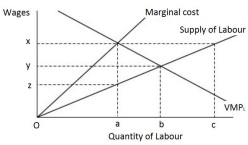
7. If a firm faced the market for labour as shown above, it will hire ____ labourers and pay ____ wages. a. Ob, Oy
b. Oa, Oz
c. Oc, Ox
d. Oa, Ox

8. Suppose the government wanted to impose a wage that would result inanefficient allocation of labour, similar to what a perfectly competitive labour market would yield, it would set the wage at _____ and ______ labour would be employed. a. Oy, Ob
b. Oz, Oa
c. Ox, Oc
d. Ox, Oa
9. Under what conditions might one expect wages to be above the prevailingcompetitive levels?
a. Only in the case where the employer is a monopolist in the product market
b. Only in the case where a union exists
c. Only in the cases in which the employer has market power in the product market
d. In cases in which the employer is a monopolist, an oligopolist, or a monopolisticcompetitor in the output market
10. If an employer is competitive in the labour market:
a. It has to pay at least the going wage
b. It can pay at most the going wage
c. The wage level is independent of the structure of the product market
d. None of the above
11. Which of the following statements about a payroll tax is true?
a. It generally reduces the quantity demanded of workers
b. It is borne entirely by workers if the supply of labour is perfectly elastic
c. It reduces the quantity demanded of workers if the supply of labour is perfectlyinelastic
d. It is borne entirely by employers if demand is perfectly inelastic
12. Which of the following statements is true? The burden of a payroll tax is paid:
a. By workers if the supply of labour is perfectly elastic
b. By workers if the demand for labour is perfectly inelastic
c. By both workers and firms if the elasticities of demand and supply of labour arebetween zero and infinity
d. By firms if they are legally responsible for remitting the tax to the governmen
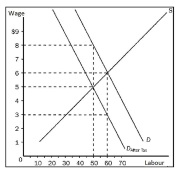
13. Refer to the diagram above. The burden of the payroll tax depicted is __for employers and __ for employees.
a. $2; $1
b. $1; $2
c. $3; $2
d. $2; $3
14. Consider the diagram for a labour market in which the relevant job attributeis job safety. Why are the isoprofit curves concave?
a. Because paying higher wages and providing a safer environment for the workers are both costly for the employer.
b. Because the isoprofit curves of a firm cannot cross.
c. Because there is a negative trade-off between job safety and wages.
d. Because it becomes more and more costly for the employer to maketheworkplace progressively safer.
15. The isoprofit schedule exhibits a(n) _________ between wages and job safetylevels. a. Increasing marginal rate of transformation
b. Diminishing marginal rate of transformation
c. Diminishing marginal rate of substitution
d. Increasing marginal rate of substitution
16. The employers' offer curve shows which of the following
a. The maximum compensating wages that will be offered in the labour market for various levels of safety
b. The minimum compensating wages that will be offered in the labour market for various levels of safety
c. The wage levels offered by employers that are dependent on the required levels of safety and health
d. The employers' preferred combination of wage and safety levels
17. The curvature of the iso-utility curve illustrates:
a. A diminishing marginal rate of transformation between wages and job safety
b. A diminishing marginal rate of substitution between wages and job safety
c. The diminishing marginal rate of technical substitution between wages andjobsafety
d. The amount safety that can be exchanged for wages on the labour market
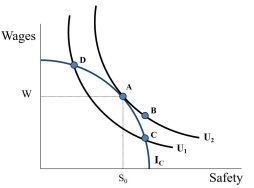
18. Which point in the diagram refers to a situation where the worker (representedby the depicted indifference curves) is worse off due to improved safety at theexpense of a lower wage?
a. A
b. B
c. C
d. D
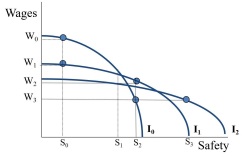
19. Refer to the diagram. Which one of the following wage and safety combinations would never be accepted by workers.
a. W0 ; S0
b. W2 ; S2
c. W3 ; S2
d. W3 ; S3
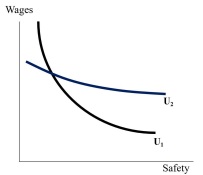
20. Consider the diagram above that show two individual's preferences for wages and safety. Which of the following statements is true?
a. Person 1 is risk adverse because she requires a lower wage increasetocompensate for a reduction in safety compared to Person 1.
b. Person 1 is risk adverse because she requires a higher wage increasetocompensate for a reduction in safety compared to Person 2.
c. Person 2 is a risk adverse because she requires a lower wage increasetocompensate for a reduction in safety compared to Person 1.
d. Person 2 is risk adverse because she requires a higher wage increasetocompensate for a reduction in safety compared to Person 1.
21. Risk-averse workers
a. have shallow wage-risk indifference curves when risk is graphed on the x-axis.
b. are willing to work in riskier environments for a relatively low increase inthe wage.
c. are willing to accept large wage decreases in exchange for a safer workenvironment.
d. never work in risky environments.
22. Which of the following is not a property of isoprofit curves graphed in safety(x-axis) versus wage (y-axis) space?
a. All points on each isoprofit curve yield the same level of profit.
b. Profit-maximizing firms are indifferent as to where they operate on any givencurve.
c. Isoprofit curves moving in the north-east direction depict higher profits.
d. Isoprofit curves moving in the south-west direction depict higher profits.
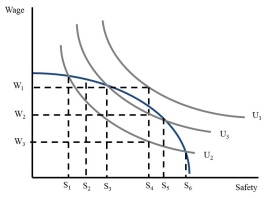
23. Refer to the figure above and assume that the worker perceives their level of jobsafety as S4 and accept a wage of W1. What is the worker's actual level of utility andlevel of safety exposure?
a. U1 ; S4
b. U2 ; S1
c. U3 ; S5
d. U3 ; S3
24. Refer to the figure on the left and assume that the worker perceives their level of job safety as S4 and accept a wage of W1. What is the range of safety levels that, if imposed by the government, would increase the worker's utility?
a. S3 - S4
b. S1 - S4
c. S3 - S5
d. S1 - S6
25. Which of the followings is correct?
a. In a competitive market, imposing safety regulation is easy since all firms will adopt it right away due to the market competition.
b. In a competitive market, a legislated increase in safety will make people better off
c. In a competitive market, the application of uniform safety standard will weedout the firms whose safety technology is not sufficient to meet the standard.
d. None of the above is correct.
26. Suppose Anna is considering taking a graphic design training programthat involves direct costs of $3,000 and forgone earnings of $5,000 in year 0. The trainingprogram will increase Anna's earnings by $3,000, $4,000, and $5,000 for the 3 years she plans on working. What is the net present value of the training program if the discount rate is 10%:
a. $6,789
b. $1,787
c. $3,305
d. $0
27. The opportunity cost of obtaining human capital is:
a. The direct costs of books, supplies, and tuition fees
b. The income foregone while acquiring human capital
c. The estimate of the increase in salary that results from the acquisition of skills
d. None of the above
28. Mary is an 18-year-old high school graduate who can take a job paying $30,000without further education. The prevailing interest rate is 10 percent. Nowassumethat after completing a one-year post-secondary program, Mary would earn $60,000per year. The present value from age 18 to age 20 would now be given by:
a. $120,000
b. $109,909
c. $104,132
d. $82,066
29. The rule for optimal human capital investment is that:
a. The individual should increase years of education until the discounted present value of the benefits of an additional year of education equals the discountedpresent value of the additional costs
b. The individual should increase years of education until the discounted present value of the benefits of an additional year of education is less thanthediscounted present value of the additional costs
c. The individual should increase years of education until the discounted present value of the benefits of an additional year of education is greater thanthediscounted present value of the additional costs
d. The individual should increase years of education until the discounted present value of the benefits of all of the years of education equals the discountedpresent value of all of the associated costs
30. According to the signalling theory of education,
a. The level of education or training directly measures the productivity of theworker
b. The level of education or training of one worker affects the productivity of her co-workers
c. Education and training function as utility generating goods fromthe worker's perspective
d. Education and training do not contribute directly to productivity, but as a filter toscreen candidates
31. The essence of human capital theory is that:
a. Firms spend money on their capital stock and equipment in order to labour tobecome more productive
b. Investments are made in human resources so as to improve their productivityand therefore their earnings
c. All workers who want to increase their salary should obtain a university diplomad. Workers invest in it in order to send a signal to potential employers regardingtheir true productivity levels
32. In the context of discounted present value, under what conditions can the sumof the income earned in each period divided by the discounting factor be replacedbythe payment divided the rate of interest?
a. When the stream of payments is collected over a long period of time
b. When the interest rate is high. c. When the payments are variable over time
d. When the costs of obtaining the education are zero
33. Which of the followings regarding "education as a signalling"is correct?
a. Higher educated workers have higher productivity
b. Lower educated workers have lower productivity
c. The role of education in this model, is only used as a filter, which has no effect on worker's productivity
d. Higher educated workers may have higher marginal costs to obtain education
34. Which of the following incorrectly addressing the problem of "ability bias"?
a. In the earning function, lnY = a + bS + e, where log wages depend only onthelevel of schooling, S, and unobserved talent, e. The OLS estimate of the returntoschooling b is biased, because unobserved talent, e, is correlated with schooling
b. The estimated coefficient may overstate the true causal effect, if more highlyeducated individuals would have earned more than less educated individuals even with the same amount of schooling as the less educated.
c. The estimated coefficient may understate the true causal effect, if more highlyeducated individuals would have earned more than less educated individuals even with the same amount of schooling as the less educated.
d. The problem of "ability bias" can be addressed by "natural experiments" technology.
35. If incomes rise for both low-income and high-income workers, but rise less for the high-income workers, a. then poverty will rise and inequality will fall. b. then poverty will fall and inequality will rise. c. then poverty will rise and inequality will rise. d. then poverty will fall and inequality will fall. 36. Wage differentials across individual workers are determined in part by:
a. Effort.
b. Productivity.
c. Social capital.
d. All of the above.
37. The positive correlation between ability and human capital investments "stretches out" wages in the population, generating what?
a. A positively skewed wage distribution.
b. A negatively skewed wage distribution.
c. An inconsistent wage distribution.
d. A uniform wage distribution.
38. Which of the following measures would best allow one to compare the relativewealth of poor households to the typical household in an economy?
a. The perfect-equality Lorenz curve.
b. The Gini coefficient.
c. The 90-10 wage gap.
d. The 50-10 wage gap.
39. Which element of the Oaxaca Decomposition reflects the wage discrimination?
a. The differences in the estimated coefficients between the male and the femalewage equations
b. The differences in the attributes between men and women
c. The differences in the predicted wages between men and women
d. The explained component of the wage differential
40. Which element of the Oaxaca Decomposition reflects the wage discrimination?
a. The differences in the attributes between men and women
b. The differences in the predicted wages between men and women
c. The explained component of the wage differential
d. None of the choices are correct.
41. Tom loses his job and immediately begins looking for another. Other things thesame, the unemployment rate
a. increases, and the labor-force participation rate decreases.
b. increases, and the labor-force participation rate is unaffected.
c. is unaffected, and the labor-force participation rate increases.
d. decreases, and the labor-force participation rate is unaffected.
42. Suppose that some people are counted as unemployed when, to maintainunemployment compensation, they search for work only at places where they areunlikely to be hired. If these individuals were counted as out of the labor forceinstead of as unemployed,
a. both the unemployment rate and labor-force participation rate would be higher.
b. both the unemployment rate and labor-force participation rate would be lower.
c. the unemployment rate would be lower and the labor-force participationratewould be higher.
d. the unemployment rate would be higher and the participation rate wouldbelower.
43. Discouraged workers
a. are not counted either as part of the adult population or as part of the labor force.
b. are counted as part of the adult population, but not as part of the labor force.
c. are counted as part of the adult population, and as unemployed.
d. None the above are correct.
44. Unemployment that results because it takes time for workers to search for thejobs that best suit their tastes and skills is called
a. the natural rate of unemployment.
b. cyclical unemployment.
c. structural unemployment.
d. frictional unemployment.
45. People who are unemployed because of job search are best classified as
a. cyclically unemployed.
b. structurally unemployed.
c. frictionally unemployed.
d. discouraged workers.
46. Evidence from research studies by economists
a. show that increased unemployment benefits decrease the job-search efforts of the unemployed.
b. show that increased unemployment benefits have virtually no effect onthejob-search efforts of the unemployed.
c. show that increased unemployment benefits increases the job-search effort of the unemployed.
d. find no clear-cut evidence on what increased unemployment benefits doto job-search efforts.
47. An increase in the minimum wage would
a. increase both the quantity demanded and the quantity supplied of labor.
b. decrease both the quantity demanded and the quantity supplied of labor.
c. increase the quantity of labor demanded while decreasing the quantity supplied.
d. decrease the quantity of labor demanded while increasing the quantity supplied.
48. Which of the following is correct concerning minimum wage laws?
a. They are a major cause of unemployment in the U.S.
b. They probably have the most impact on those with the least skills andleast experience.
c. About 20 percent of full-time workers age 25 who receive hourly wages report they earn the minimum wage or less.
d. All of the above are correct.
49. Which of the following is not correct?
a. A union is a form of cartel.
b. Union workers typically earn 25 to 33 percent more than similar nonunionizedworkers.
c. The power of a union comes from its ability to strike if its demands are not met.
d. Workers in unions reap the benefits of collective bargaining, while workers not inunions bear some of the cost.
50. When employers pay efficiency wages, they pay wages
a. below equilibrium to increase profitability.
b. above equilibrium to increase productivity.
c. set by the government to counter charges of unfair labor practices.
d. at a level that would prevail in the absence of unions.
Section B: Short Answer Question.
1. Suppose all workers have the same preferences represented by: where w is the wage and x is the proportion of the firm's air that is composed of toxicpollutants. There are only two types of jobs in the economy, a clean job (x=0) andadirty job (x=l). Let w0 be the wage paid by the clean job and w1 be the wage paidbythe polluted job.
a. If the clean job pays $16 per hour, what is the wage in dirty jobs?
b. What is the compensating wage differential?
2. Since unemployment rates are consistently higher in Canada and some WesternEuropean countries than in the United States, it appears that the natural rateof unemployment is lower in the United States. What might explain this difference?